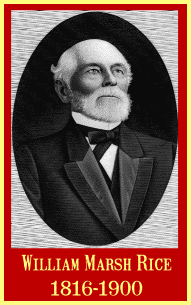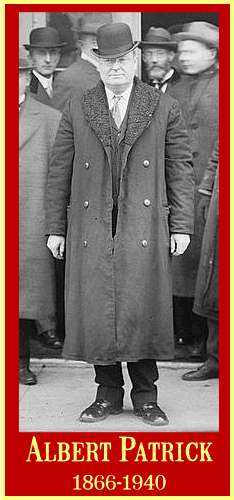The Murder of Millionaire William Rice by Albert Patrick, 1900
Story by Thomas Duke, 1910
“Celebrated Criminal Cases of America”
Part III: Cases East of The Pacific Coast
William Marsh Rice resided in Houston, Texas, for many years, and accumulated a fortune of $7,000,000.
His wife died in Waukesha, Wis., in 1896 under peculiar circumstances.
Just previous to her death, she drew up a will disposing of $2,500,000 worth of community property. A man named Holt was executor of this will, which Rice contested bitterly.
On September 16, 1896, after the death of his wife, Rice made a will leaving the bulk of his wealth to the “William M. Rice Institute for the Advancement of Literature, Science and Art,” which he had founded in Texas in 1891.
This will was drawn up by Captain James A. Baker, a prominent Texas attorney.
About the time of his wife’s death, Rice, accompanied by his Secretary, Charles T. Jones, left Texas to take up his residence in New York City, where he engaged apartments at the Berkshire, No. 500 Madison Avenue. Jones was then 23 years of age, while Rice had passed his 81st year and was extremely eccentric.
Attorney Albert T. Patrick of New York formerly resided in Houston, Texas, and he transacted some legal business in relation to Mrs. Rice’s will for Attorney Holt, the executor. At this time neither Rice nor Jones had met Patrick, but the former despised him because he had been informed that Patrick had done some “dirty work” in regard to the will for Holt.
 One evening in November, 1899, Patrick called at Rice’s apartments in New York and was met at the door by Jones.
One evening in November, 1899, Patrick called at Rice’s apartments in New York and was met at the door by Jones.
Patrick gave an assumed name and stated that he desired to see Mr. Rice regarding a deal in Cotton. Jones stated that Rice had retired for the night and Patrick agreed to return a few evenings later.
He did so and again Rice was in bed. After some hesitancy, Patrick disclosed his identity to Jones and stated that he was the New York representative of Holt, the executor of the will, and that he was authorized to effect a compromise, which he felt confident would be entirely satisfactory to all concerned. Jones informed Patrick of Rice’s prejudice against him, and expressed the opinion that Rice would refuse to meet him. Patrick then requested Jones not to inform Rice of his visit.
After that Patrick called frequently after Rice had retired for the night, and he and Jones became quite confidential.
In the course of conversation, Rice’s last will was discussed and Patrick slyly remarked that it was unfortunate for Jones that the bulk of the vast property would go to the Rice Institute and that Jones would receive comparatively nothing. Patrick then intimated that a “will” could be drawn up in which Jones would receive adequate compensation for faithful services rendered to Rice.
Observing that Jones was apparently impressed with this suggestion, Patrick became more bold and stated that he would draw up such a will, but as peculiarities in typewriting machines frequently make it easy to prove whether or not the work was done on a certain machine, he proposed that Jones write it on his own machine, as he attended to all of Rice’s correspondence, and it might attract attention if it could be proven that some other machine was used to write this document.
Jones expressed dissatisfaction with the provisions of the first will drawn up by Patrick, but eventually a document was prepared which was dated June 30, 1900, and which was satisfactory to both conspirators.
In this will Patrick substituted himself for the Rice Institute and to prevent Rice’s relatives from contesting the forged document he ingeniously provided them with a greater portion of the estate than was bequeathed them in the will of 1896.
Patrick convinced Jones that it might arouse suspicion if he (Jones) received a large part of the estate, but if no provision was made for him, he could have no apparent motive for being a party to a fraud and it would be taken for granted that the document was genuine. With the understanding that Patrick would pay him $10,000 per year Jones typewrote the will, which covered four pages. At the bottom of each page Rice’s signature was traced, evidently from the same model, as each was exactly the same size and shape.
At this stage of the proceedings, the thought occurred to Patrick that it might seem singular that Rice should leave him, a stranger, the bulk of his property, so he persuaded Jones to typewrite and send several letters to him (Patrick), which would furnish evidence that Rice was Patrick’s warm personal friend and in whom he reposed the greatest confidence. These letters, to which Patrick forged Rice’s name, were sent through the mail, and at Patrick’s suggestion Jones placed a copy of each in Rice’s letter file. Patrick also forged Rice’s name to numerous checks, which Jones sent out in his capacity as private secretary—the object being to gather these checks afterward if necessary and show by them that the signatures on them and on the will was in the same handwriting.
Jones also gave Patrick a typewritten order for securities and cash in different safe deposit vaults, to which Patrick forged Rice’s name.
In the early part of August, 1900, Jones informed Patrick that Rice seemed to be improving in health. Patrick then gave Jones a very significant glance and asked:
“Don’t you think he is living too long for our interests?”
After some hesitation he remarked that if Jones would let him in some night he would soon put Rice out of the way.
Dr. Curry, a friend of Jones’, but who had no connection with this conspiracy, prescribed mercury for Jones, and Patrick suggested that Rice be given a dose of it at frequent intervals to weaken his system preparatory to administering chloroform.
Patrick stated that a physician’s prescription was necessary to procure chloroform in New York, so Jones communicated with his brother in Texas, who innocently forwarded the amount requested.
The mercurial pills caused severe diarrhoea, and Dr. Curry was called in and prescribed medicine for Rice, but in ignorance of the cause of the disorder.
It was intended to continue administering mercury to Rice for many days before chloroforming him, but Rice, for some reason unknown to Jones, sent a telegram to Captain Baker, his attorney in Texas, requesting him to come to New York at once. Rice also informed Jones that he intended to expend $2,500,000 in reconstructing a mill in Texas. Jones communicated this information to Patrick, and it was then decided to act at once.
At 8 p.m., on Saturday, September 22, while Rice was sleeping soundly, Jones saturated a small sponge with chloroform, and putting it in a towel shaped into a cone, he placed it on Rice’s face. At the expiration of thirty minutes, Rice appeared lifeless. Jones then removed the cone and, after burning it in the stove, he opened the windows and notified Patrick and Dr. Curry that Rice was very low. The doctor and lawyer arrived together, and after a brief examination it was found that Rice was dead, and the doctor signed a death certificate, assigning old age, a weak heart and collocratel diarrhea as the cause of Rice’s demise.
In the early part of September, Jones, acting under Patrick’s instructions, typewrote a letter, purporting to be from Rice to Patrick, in which Rice instructed Patrick to have his body cremated.
Acting in accordance with these “instructions,” Patrick took charge of the body and ordered an undertaker to have it cremated immediately, but when informed that the cremation could not take place the next day, he requested that the remains be embalmed at once.
Immediately after the undertaker left, Patrick searched Rice’s room and took $450 in bills, valuable securities and jewelry.
On the following Monday, Patrick instructed Jones to fill out checks from Rice’s checkbook, aggregating $250,000, on the Fifth Avenue Trust Co. and on Swenson & Sons’ bank, made payable to Albert Patrick, to which the latter forged Rice’s signature.
Through an oversight on Jones’ part, he misspelled Patrick’s first name on one of the checks on Swenson’s bank. Patrick also overlooked this defect, and when he went to the bank to draw the money, he signed his correct name “Albert Patrick” on the back of the check.
The clerk then called his attention to the fact that the check was made payable to A-b-e-r-t Patrick, and refused to pay the money until he had communicated with Rice. The clerk then telephoned to Rice’s apartments, and Jones assured him that Patrick was all right.
The clerk expressed a desire to speak to Rice personally, whereupon Jones, after a slight hesitation, stated that Rice was dead. The entire transaction aroused the suspicion of the bankers, and Max Gumpel, the San Francisco handwriting expert, who was then in New York, was consulted, and he immediately pronounced the signature of Rice a forgery.
In the meantime, Patrick made arrangements to have Rice’s body cremated on Tuesday, and he telegraphed to Holt, the executor of Mrs. Rice’s will, that he had an agreement signed by Rice which would end the litigation.
The authorities decided to perform an autopsy on Rice’s body, and at the inquest physicians testified that all the organs were normal except the lungs, which were congested.
They also testified that nothing could have caused that congestion but the inhalation of some gaseous irritant. Chemist Witthaus testified that his analysis revealed the presence of mercury, but not in quantities sufficient to cause death.
 On October 4, Patrick and Jones were arrested on a charge of forgery.
On October 4, Patrick and Jones were arrested on a charge of forgery.
In some manner, Patrick, who feared Jones would testify for the State, passed a knife into his cell and suggested that they jointly commit suicide. Jones made the attempt by cutting his throat, but the wound was not fatal.
In January, 1901, Jones made a complete confession of the facts as related above, and Patrick was then charged with murder.
When Jones became a witness for the State, he was removed from the prison, furnished with comfortable quarters in an apartment house, and permitted to go to places of amusement.
At the trial numerous experts were produced who testified that the will and checks were forgeries, and Jones’ brother from Texas and the express agents testified regarding the sending of the chloroform with which Rice was murdered.
Patrick was found guilty and sentenced to be electrocuted but the Governor commuted the sentence to life imprisonment.
The case was appealed to the Court of Appeals, but a new trial was denied. Judge Denis O’Brien rendered a dissenting opinion, in which he severely criticised the authorities who granted Jones immunity and permitted him to live in luxury during the trial.
On March 5, 1909, Patrick applied to the Appellate Court for his freedom on a writ of habeas corpus. He acted as his own attorney, and stated that he had never asked to have his penalty commuted to life imprisonment. After again protesting his innocence, he cried: “Give me liberty or give me death.”
The writ was denied.
Epilogue: Doubts about the evidence caused the Governor John Alden Dix to pardon him in 1912. In 1930, he was disbarred and the disbarment was upheld by the New York State Supreme Court. It was said that the conduct of the case during the 12 years between being charged and being pardoned cost Patrick and his friends $162,000. Patrick died in Tulsa, Oklahoma on February 11, 1940.
—###—



